| Page last updated
24 April 2009 |
Freshwater Mussels of Madagascar and the Mascarene Islands
Over the course of our worldwide collection-crawl and review of the literature on Afrotropical freshwater mussel diversity, we have encountered reports of freshwater mussels from Madagascar and the Mascarene Islands of Mauritius and Reunion. Of the nine separate species reported from those islands in the southwestern Indian Ocean, we are confident on only one: Etheria elliptica. We have described a new genus for the another species, Germainaia geayi. The remaining seven are the result of errors and over-active imaginations.
 Madagscar is a large, continental landmass currently located 400-1000 km off the coast of southeastern Africa. Those two continents were both a part of the larger supercontinent of Gondwana until it disintegrated during the Mesozoic. Because freshwater mussels are notoriously poor dispersers across oceanic and terrestrial barriers, it is widely assumed that the presence of the presence of freshwater mussels on Madagascar is the result vicariance due to continental drift. Madagscar is a large, continental landmass currently located 400-1000 km off the coast of southeastern Africa. Those two continents were both a part of the larger supercontinent of Gondwana until it disintegrated during the Mesozoic. Because freshwater mussels are notoriously poor dispersers across oceanic and terrestrial barriers, it is widely assumed that the presence of the presence of freshwater mussels on Madagascar is the result vicariance due to continental drift.
However, that assumption is implicitly challenged by reports of the Unionoida on the Mascarene Islands. Those islands are volcanic in origin and have never been connected or in close proximity to a continental body. Thus, any freshwater mussels must have arrived via transoceanic dispersal.
As interesting as these alternative biogeographic hypotheses, they are based upon very meager data and even less modern evolutionary theory. In order to distinguish real patterns from bolonga, we recently reexamined the available evidence -- specimens and literature records -- in the light of available phylogenetic and biogeographical theory. In the end, we rejected the validity of 7 of 9 freshwater mussel species records from either Madagascar, Mauritius, or Reunion, and we described a new genus to ease the phylogenetic tension over a presumed unionid on Madagascar. A more complete discussion can be found in the following paper:
- Graf, D.L. & K.S. Cummings. 2009. Actual and alleged freshwater mussels (Mollusca: Bivalvia: Unionoida) from Madagascar and the Mascarenes, with description of a new genus, Germainaia. Proceedings of the Academy of Natural Sciences of Philadelphia 158: 221-238.
The following lists and figures the various taxa that we considered in that article.
Species Reported from Madagascar & the Mascarene Islands
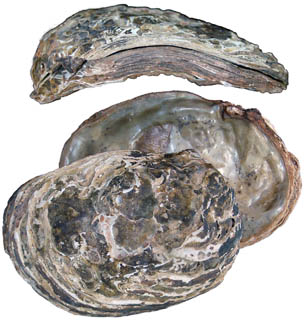 Etheria elliptica Etheria elliptica
Etheria elliptica is one of the most widespread mussels in the Afrotropics (see distrubution on figure above). It is known from Madagascar from multiple locality records in various collections. The type localities of at least two synonyms are "Madagascar". Two more synonyms (including the senior one) are listed as being marine species from the Indian Ocean.
The specimen depicted to the right is from the Sahondra River.
Based upon these distributional records, E. elliptica is really the only species that we are convinced occurred on Madagascar (but see Germainaia geayi below). However, both data and theory are equivocal on how and when the lineage may have achieved the present distribution. The systematics of the Etheriidae (the family to which Etheria belongs) is currently disputed (see Bogan & Hoeh, 2000 and Graf & Cummings, 2006), and the fossil record for this species limited. |
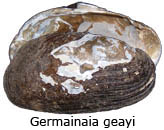 Germainaia geayi Germainaia geayi
Germainaia geayi is known only from 2.5 specimens with the vague locality "Madagascar." The species was originally described as "Unio (Nodularia) geayi" by Germain (1911). Most subsequent treatments, however, have put G. geayi in the genus Coelatura. Unio, Nodularia, and Coelatura are all genera assigned to the family Unionidae. However, we aren't completely convinced that the available material actually belongs to that family. |
 Upon first inspection of the type when we were in Paris in 2006, that specimen struck us as more similar to a hyriid, like one might find in Australia or New Zealand (such as Hyridella depressa). While members of the Unionidae and the Hyriidae can be readily distinguished based upon their soft-anatomy, we have had trouble when it comes to family-level shell synapomorphies. Upon first inspection of the type when we were in Paris in 2006, that specimen struck us as more similar to a hyriid, like one might find in Australia or New Zealand (such as Hyridella depressa). While members of the Unionidae and the Hyriidae can be readily distinguished based upon their soft-anatomy, we have had trouble when it comes to family-level shell synapomorphies.
Given the scanty material available for G. geayi and the conflicts it presents to going biogeographical hypotheses, we regard Germainaia as incertae sedis at the family level. |
"Unio madagascariensis" (nomen dubium)
This mussel is only known from the original description by Sganzin (1841), from which it is impossible to identify: its green and fragile. The locality given by Sganzin was Mahoupa River, Madagascar.

|
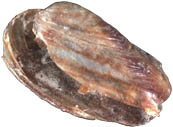 "Unio malagachensis" (nomen dubium) "Unio malagachensis" (nomen dubium)
The 12 mm type of Unio malagachensis (shown greatly enlarged to the right) was described by Germain (1911). The specimen -- both valves with the whole, juvenile animal dried up inside -- cannot even be assigned to the Unionoida with certainty, although Haas (1969) regarded U. malagachensis as a junior synonym of G. geayi. |
"Nodularia cariei" (= Coelatura aegyptiaca)
 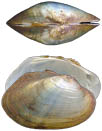 N. cariei was treated by Daget (1998) as a valid species from Reunion Island, Coelatura cariei. N. cariei was treated by Daget (1998) as a valid species from Reunion Island, Coelatura cariei.
The specimen to the left is a reproduction of Germain's (1919) figure of the type. As was pointed out by Haas (1969), it so resembles Coelature aegyptiaca from the Nile (figured right) that this nominal species must simply be considered a case of mistaken locality. |
"Unio sinuata" (= Margaritifera auricularia)
U. sinuata was also reported by Sganzin (1841) as being from Reunion (= Bourbon) Island. Typically, that name refers to Margaritifera auricularia in Europe.

We could find to specimen to back up this claim, and since Sganzin didn't believe it, neither do we. |
 "Unio brevialis" (= Potomida littoralis) "Unio brevialis" (= Potomida littoralis)
Lamarck (1819) described Unio brevialis from "l'Isle de France." That place name has been used to refer to the Paris metropolitan area, although it wasn't in common usage in Lamarck's day. At that time, Isle de France referred to the Mascarene island of Mauritius. |
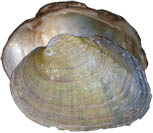 The type of U. brevialis (top right) is undoubtedly Potomida littoralis (right), a species known widely in Europe. Dispite the unambiguous assignment of the type to a well known species, Haas (1969) actually hedged his bets by treating U. brevialis both ways: as a synonym of P. littoralis and as Coelatura brevialis from Mauritius. The type of U. brevialis (top right) is undoubtedly Potomida littoralis (right), a species known widely in Europe. Dispite the unambiguous assignment of the type to a well known species, Haas (1969) actually hedged his bets by treating U. brevialis both ways: as a synonym of P. littoralis and as Coelatura brevialis from Mauritius.
We regard U. brevialis to be a synonym of P. littoralis, absent from Mauritius. |
"Unio mauritianus" (= Simpsonella purpurea)
 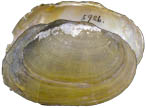 Lea (1859) named Unio mauritianus for Mauritius (figured left), which he considered to be the type locality. Lea (1859) named Unio mauritianus for Mauritius (figured left), which he considered to be the type locality.
Subsequent treatments (e.g., Haas, 1969) have regarded this nominal species to be a junior synonym of Simpsonella purpurea (figured right), endemic to the Philippines. |
"Unio fluctiger" (= Diplodon fluctiger)
  The specimen on the left is from the Academy of Natural Sciences in Philadelphia and is labeled as being Unio fluctiger from Mauritius. The type of Unio fluctiger (right) described by Lea (1859), however, is believed to occur in the Yuruari River of South America (Simone, 2006). The specimen on the left is from the Academy of Natural Sciences in Philadelphia and is labeled as being Unio fluctiger from Mauritius. The type of Unio fluctiger (right) described by Lea (1859), however, is believed to occur in the Yuruari River of South America (Simone, 2006).
|
References
- Bogan, A.E. & W.R. Hoeh. 2000. On becoming cemented: evolutionary relationships among the genera in the freshwater bivalve family Etheriidae (Bivalvia: Unionoida). p. 159-168. In: Harper, E.M., J.D. Taylor & J.A. Crame (eds.). The Evolutionary Biology of the Bivalvia. Geological Society, London, Special Publications, vol. 177. The Geological Society of London, London, 494 p.
- Daget, J. 1998. Catalogue raisonné des Mollusques bivalves d'eau douce africains. Backhuys Publishers/Orstom, Leiden/Paris.
- Germain, L. 1911. Les Unionidae de Madagascar. Bulletin du Muséum National d'Histoire Naturelle, 17: 136-140.
- Germain, L. 1919. Contributions à la faune malacologique de Madagascar. VII. Un pélécypode nouveau des rivières de l'Île de La Réunion. Bulletin du Muséum National d'Histoire Naturelle, 25: 121-122.
- Graf, D. L. & K. S. Cummings. 2006. Palaeoheterodont diversity (Mollusca: Trigonioida + Unionoida): what we know and what we wish we knew about freshwater mussel evolution. Zoological Journal of the Linnean Society 148: 343-394.
- Haas, F. 1969. Superfamilia Unionacea. Das Tierreich, Lief. 88. Walter de Gruyter and Co., Berlin.
- Lamarck, J B. 1819. Histoire Naturelle des Animaux sans Vertèbres, Vol. 6, part 1. Chez l'Auteur, au Jardin du Roi., Paris.
- Lea, I. 1859. Descriptions of twenty-one new species of exotic Unionidae. Proceedings of the Academy of Natural Sciences of Philadelphia 11: 151-154.
- Sganzin, V. 1841. Catalogue des coquilles aux Îles de France, de Bourbon et de Madagascar. Mémoires de la Société d'Histoire Naturelle de Strasbourg 8:1-30.
- Simone, L.R.L. 2006. Land and Freshwater Molluscs of Brazil. EGB, Fapesp, São Paulo.
|